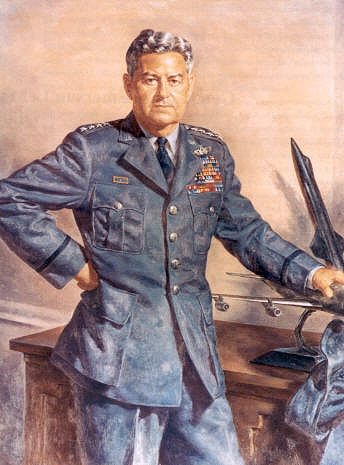|
People |
|
General Curtis Emerson
Lemay
|
 |
General Curtis Emerson Lemay was the “Father of the Strategic Air
Command.” When he took over as its commander in 1948, it consisted of
little more than a few understaffed and untrained B-29 groups left over
from World War II. Less than half its aircraft were operational and the
crews were next to worthless. He ordered a mock bombing raid on Dayton,
Ohio, and most of the bombers missed their targets by one to two miles.
That was unacceptable.
He subjected his men to vigorous training and long
hours of hard work, but fought for additional pay and better housing to
make their demanding lives more tolerable. He obtained vast fleets of new
bombers, established a vast aerial refueling system, started many new
units and bases, began missile development, and established a strict
command and control system. When he left the command in 1957 to
assume his new job as Air Force Vice Chief of Staff, SAC was the most
powerful military force the world had ever seen.
But that was only one of his many accomplishments. He
was the outstanding air combat leader of World War II. He developed
the bombardment tactics and strategies that left Nazi Germany in rubble.
He was transferred to the Pacific theater, where he took over command of
the B-29’s and led the air war against Japan. He incinerated every major
Japanese city and oversaw the dropping of the atomic bombs. After the war,
he organized he famous Berlin Air Lift. It was this confrontation that
began the Cold War and resulted in Lemay being given the job of whipping
the fledging Strategic Air Command into shape..
He was always the best pilot, best navigator and best
bombardier in ever unit he ever served or commanded. He often
demonstrated his courage by personally leading his bombers on the
dangerous missions, including what many regard as the most dangerous
mission ever flown - the attack on Regensberg, Germany. The Army Air
Forces lost half of the 1,000 planes |
|
launched that day, which
has gone down in Air Force history as “Black Thursday.” If his crews
weren’t flying missions, then they were subjected to his relentless
training. He believed it was the key to saving their lives and more
quickly ending the war. They called him "Iron Ass" because he demanded so
much, but they respected him immensely. A popular story that was widely
circulated in SAC is that he approached a fully-fueled bomber with his
ever-present cigar stuck firmly between his lips. A guard asked him to
put it out, as it might blow up the aircraft. Lemay replied, “It wouldn’t
dare.”
Curtis Lemay served as a general for seventeen years -
longer than any other man in the history of the United States military.
He received every award his country could bestow, other than the Medal of
Honor. He was decorated by many other nations. In 1961, he became the Air
Force Chief of Staff, it’s highest position.
He was the Cold War's fiercest warrior. His very first
war plan drawn up in 1949, proposed delivering, "the entire stockpile of
atomic bombs in a single massive attack." That meant dropping 133
A-bombs on 70 cities within 30 days. He argued that, "if you are going to
use military force, then you ought to use overwhelming military force. Use
too much and deliberately use too much.. you’ll save lives, not only your
own, but the enemy's too."
The old warrior died on Oct. 1, 1990. He is buried in
the United States Air Force Academy Cemetery at Colorado Springs,
Colorado. |
|
